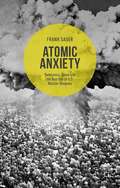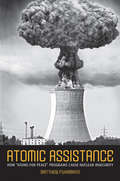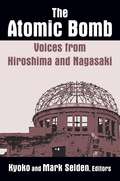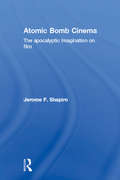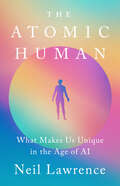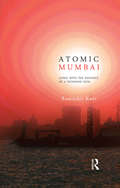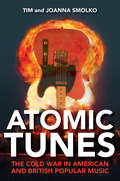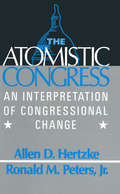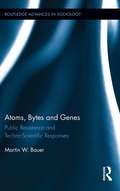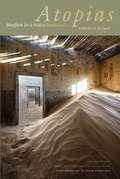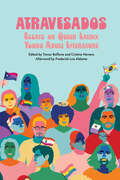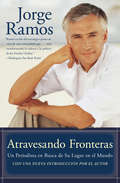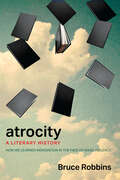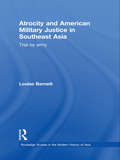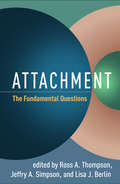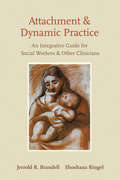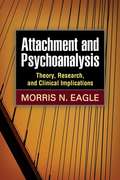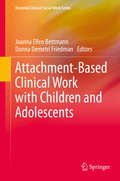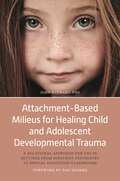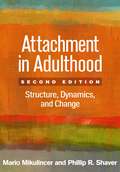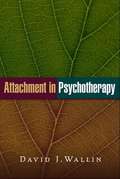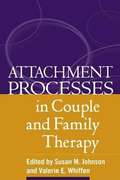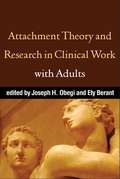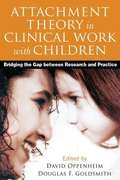- Table View
- List View
Atomic Anxiety: Deterrence, Taboo And The Non-use Of U. S. Nuclear Weapons
by Frank SauerWith the concept of 'Atomic Anxiety', this book offers a novel perspective on one of the most important and longstanding puzzles of international politics: the non-use of U.S. nuclear weapons. By focusing on the fear surrounding nuclear weapons, it explains why nuclear deterrence and the nuclear taboo are working at cross purposes in practice.
Atomic Assistance
by Matthew FuhrmannNuclear technology is dual use in nature, meaning that it can be used to produce nuclear energy or to build nuclear weapons. Despite security concerns about proliferation, the United States and other nuclear nations have regularly shared with other countries nuclear technology, materials, and knowledge for peaceful purposes. In Atomic Assistance, Matthew Fuhrmann argues that governments use peaceful nuclear assistance as a tool of economic statecraft. Nuclear suppliers hope that they can reap the benefits of foreign aid-improving relationships with their allies, limiting the influence of their adversaries, enhancing their energy security by gaining favorable access to oil supplies-without undermining their security. By providing peaceful nuclear assistance, however, countries inadvertently help spread nuclear weapons. Fuhrmann draws on several cases of "Atoms for Peace," including U.S. civilian nuclear assistance to Iran from 1957 to 1979; Soviet aid to Libya from 1975 to 1986; French, Italian, and Brazilian nuclear exports to Iraq from 1975 to 1981; and U.S. nuclear cooperation with India from 2001 to 2008. He also explores decision making in countries such as Japan, North Korea, Pakistan, South Africa, and Syria to determine why states began (or did not begin) nuclear weapons programs and why some programs succeeded while others failed. Fuhrmann concludes that, on average, countries receiving higher levels of peaceful nuclear assistance are more likely to pursue and acquire the bomb-especially if they experience an international crisis after receiving aid.
The Atomic Bomb: Voices from Hiroshima and Nagasaki (Japan In The Modern World Ser.)
by Mark Selden Kyoko Iriye SeldenThis collection of factual reports, short stories, poems and drawings expresses in a deeply personal voice the devastating effects of the bombings of Hiroshima and Nagasaki.
Atomic Bomb Cinema: The Apocalyptic Imagination on Film
by Jerome F. ShapiroUnfathomably merciless and powerful, the atomic bomb has left its indelible mark on film. In Atomic Bomb Cinema, Jerome F. Shapiro unearths the unspoken legacy of the bombing of Nagasaki and Hiroshima and its complex aftermath in American and Japanese cinema. According to Shapiro, a "Bomb film" is never simply an exercise in ideology or paranoia. He examines hundreds of films like Godzilla, Dr. Strangelove, and The Terminator as a body of work held together by ancient narrative and symbolic traditions that extol survival under devastating conditions. Drawing extensively on both English-language and Japanese-language sources, Shapiro argues that such films not only grapple with our nuclear anxieties, but also offer signs of hope that humanity is capable of repairing a damaged and divided world. www.atomicbombcinema.com
The Atomic Human: What Makes Us Unique in the Age of AI
by Neil D. LawrenceFrom a renowned computer scientist, this book seeks the distinctive human quality that will prevail against artificial intelligence. If artificial intelligence takes over decision-making what, then, is unique and irreplaceable about human intelligence? The Atomic Human is a journey of discovery to the core of what it is to be human, in search of the qualities that cannot be replaced by the machine. Neil Lawrence brings a timely, fresh perspective to this new era, recounting his personal journey to understand the riddle of intelligence. By contrasting our own intelligence with the capabilities of machine intelligence through history, The Atomic Human reveals the technical origins, capabilities, and limitations of AI systems, and how they should be wielded–not just by the experts, but ordinary people.
Atomic Mumbai: Living with the Radiance of a Thousand Suns
by Raminder KaurAtomic Mumbai offers an insightful historical and ethnographic account of how nuclear issues are represented in popular culture, print media, films, documentaries, advertising and superhero comics, driven by perceptions of those based in the city of Mumbai, a prime site of nuclear establishments in India since the mid-1940s. Based on long-term fieldwork, and including rare photographs, narratives and extensive interviews, the volume documents urban nuclear imaginaries, along with their terrifying association with genetic mutation and death.
Atomic Tunes: The Cold War in American and British Popular Music
by Tim Smolko Joanna SmolkoWhat is the soundtrack for a nuclear war? During the Cold War, over 500 songs were written about nuclear weapons, fear of the Soviet Union, civil defense, bomb shelters, McCarthyism, uranium mining, the space race, espionage, the Berlin Wall, and glasnost. This music uncovers aspects of these world-changing events that documentaries and history books cannot. In Atomic Tunes, Tim and Joanna Smolko explore everything from the serious to the comical, the morbid to the crude, showing the widespread concern among musicians coping with the effect of communism on American society and the threat of a nuclear conflict of global proportions. Atomic Tunes presents a musical history of the Cold War, analyzing the songs that capture the fear of those who lived under the shadow of Stalin, Sputnik, mushroom clouds, and missiles.
The Atomistic Congress: Interpretation of Congressional Change
by Allen D. Hertzke Ronald M. PetersFirst Published in 1993. Routledge is an imprint of Taylor & Francis, an Informa company.
Atoms, Bytes and Genes: Public Resistance and Techno-Scientific Responses (Routledge Advances in Sociology #126)
by Martin W. Bauer"Atom," "byte" and "gene" are metonymies for techno-scientific developments of the 20th century: nuclear power, computing and genetic engineering. Resistance continues to challenge these developments in public opinion. This book traces historical debates over atoms, bytes and genes which raised controversy with consequences, and argues that public opinion is a factor of the development of modern techno-science. The level and scope of public controversy is an index of resistance, examined here with a "pain analogy" which shows that just as pain impacts movement, resistance impacts techno-scientific mobilization: it signals that something is wrong, and this requires attention, elaboration and a response to the challenge. This analysis shows how different fields of enquiry deal with the resistance of social-psychological mentalities in the face of industrial, scientific and political activities inspired by projected futures.
Atopias: Manifesto for a Radical Existentialism (Lit Z)
by Frédéric NeyratThis book offers a manifesto for a radical existentialism aiming to regenerate the place of the outside that contemporary theory underestimates. Neyrat calls this outside “atopia”: not utopia, a dreamt place out of the world where everything would be perfect, but atopia, the internal outside that is at the core of every being. Atopia is neither an object that an “object-oriented ontology” would be able to formalize, nor the matter that “new materialisms” could identify. Atopia is what constitutes the existence of any object or subject, its singularity or more precisely its “eccentricity.” Etymologically, to exist means “to be outside” and the book argues that every entity is outside, thrown in the world, wandering without any ontological anchor. In this regard, a radicalized existentialism does not privilege human beings (as Sartre and Heidegger did), but considers existence as a universal condition that concerns every being.It is important to offer a radical existentialism because the current denial of the outside is politically, and aesthetically, damaging. Only an atopian philosophy—a bizarre, extravagant, heretic philosophy—can care for our fear of the outside. For therapeutic element, a radical existentialism favors everything that challenges the compact immanence in which we are trapped, losing capacity to imagine political alternatives. To sustain these alternatives, the book identifies the atopia as a condition of the possibility to break immanence and analyze these breaks in human and animal subjectivity, language, politics and metaphysics.
Atravesados: Essays on Queer Latinx Young Adult Literature (Children's Literature Association Series)
by Trevor Boffone and Cristina HerreraContributions by Frederick Luis Aldama, Trevor Boffone, T. Jackie Cuevas, Cristina Herrera, Alexander Lalama, Angel Daniel Matos, Regina Marie Mills, Joseph Isaac Miranda, Jesus Montaño, Domino Renee Pérez, Regan Postma-Montaño, Cristina Rhodes, and Sonia Alejandra RodríguezAtravesados: Essays on Queer Latinx Young Adult Literature shows how Latinx queer YA writers discard the “same old story,” and offer critical representations of queerness that broaden YA writing and insist on the presence of queer teens of color. Atravesados draws on foundational Chicana queer theorist Gloria Anzaldúa’s notion of “atravesados” to speak to the spectrum of queer youth Latinidades as they materialize in YA literature. Los atravesados, according to Anzaldúa, are “the squint-eyed, the perverse, the queer, the troublesome, the mongrel, the mulato, the half-breed, the half dead; in short, those who cross over, pass over, or through the confines of the ‘normal.’” Los atravesados reside in the borderlands space of ni de aquí ni de allá, neither here nor there, present yet liminal, their queerness the very source of both frustration and empowerment, a paradox of joy and tragedy. Although written in 1987, Anzaldúa’s theory speaks to the realities of queer Latinx teens that fill the pages of YA literature well into the twenty-first century. Characters such as Juliet from Gabby Rivera’s Juliet Takes a Breath, Aaron from Adam Silvera’s More Happy Than Not, or the titular Chulito from Charles Rice-Gonzales’s novel encompass the highs, lows, and everything in-betweenness of queer Latinx teen lived experiences. This collection tells their stories.Contributors speak to the spectrum of queer youth Latinidades as they materialize in YA literature, paying close attention to representation and the ways youth are portrayed—whether accurate or stereotypical. Close attention is paid to books that succeed in broadening the field of YA, highlighting authors that draw from their own lived experiences and situate strong, fully developed characters. Taken together, these essays move beyond the page, explaining to readers why representation and authenticity matter in YA literature, as well as the far-reaching effects they can have for real world queer Latinx teens.
Atravesando Fronteras
by Jorge RamosRelato autobiográfico. Revela toda clase de detalles sobre la vida del famoso periodista Jorge Ramos. Por primera vez, este prestigiado presentador de noticias en Español comparte anécdotas conocidas y ocultas de su existencia con los lectores, televidentes y radioescuchas que han seguido atentos su despuntante carrera profesional. Descubrimos aquí al hombre cuya atracción por las emociones fuertes lo ha puesto reiteradamente en peligro, y cuyo sentido del humor lo ha salvado de las situaciones más incómodas. Padre, reportero, esposo e hijo; todas sus facetas se describen aquí, sin escatimar recursos. El sentido aventurero y práctico del protagonista nos brindará con la lectura, además, una excelente lección de vida. Los pasajes intensamente contados en el libro nos permitirán viajar de la mano de una persona que se confiesa itinerante; ofreciendo, por lo tanto, un amplio archivo emocional de vivencias recogidas de múltiples lugares y encuentros con los más variados y controversiales personajes del planeta.
Atrocity: A Literary History
by Bruce RobbinsExploring literary representations of mass violence, Bruce Robbins traces the emergence of a cosmopolitan recognition of atrocity. Mass violence did not always have a name. Like conquest, what we think of now as atrocities have not always invited indignation or been seen to violate moral norms. Venturing from the Bible to Zadie Smith, Robbins explores the literature of suffering, to show how, over time, abhorrence of mass violence takes shape. With it comes the emergence of a necessary element of cosmopolitanism: the ability to look at one's own nation with the critical eyes of a stranger. Drawing on a vast written archive and with penetrating insight, Robbins takes up such literary representations of violence as Bartolomé de las Casas's account of his fellow Spaniards' atrocities, Kurt Vonnegut's Slaughterhouse-Five, Grimmelshausen's 1668 novel Simplicissimus, David Mitchell's Cloud Atlas, Gabriel García Márquez's One Hundred Years of Solitude, Homero Aridjis's short novel Smyrna in Flames, and Tolstoy's Hadji Murat. These essential texts do more than simply testify to atrocious acts. In their literariness, they take the risk of contextualizing and relativizing, thereby extending beyond the legal paradigm of accusation. They recognize atrocity as a moral scandal about which something should be done and can be done, while they also place that scandal within a larger and more uncertain history.
Atrocity and American Military Justice in Southeast Asia: Trial by Army (Routledge Studies in the Modern History of Asia)
by Louise BarnettThis book is an examination of American army legal proceedings that resulted from a series of moments when soldiers in a war zone crossed a line between performing their legitimate functions and committing crimes against civilians, or atrocities. Using individual judicial proceedings held within war-time Southeast Asia, Louise Barnett analyses how the American military legal system handled crimes against civilians and determines what these cases reveal about the way that war produces atrocity against civilians. Presenting these atrocities and subsequent trials in a way that considers both the personal and the institutional the author considers how and why atrocity happens, the terrain of justification, and the degree to which the army and American society have been willing to take military crimes against civilians seriously. Atrocity and American Military Justice in Southeast Asia will be of interest to students, scholars and professionals interested in Military Justice, Military history and Southeast Asian History more generally.
Attachment: The Fundamental Questions
by Ross A. Thompson, Jeffry A. Simpson, Lisa J. BerlinThe ongoing growth of attachment research has given rise to new perspectives on classic theoretical questions as well as fruitful new debates. This unique book identifies nine central questions facing the field and invites leading authorities to address them in 46 succinct essays. Multiple perspectives are presented on what constitutes an attachment relationship, the best ways to measure attachment security, how internal working models operate, the importance of early attachment relationships for later behavior, challenges in cross-cultural research, how attachment-based interventions work, and more. The concluding chapter by the editors delineates points of convergence and divergence among the contributions and distills important implications for future theory and research.
Attachment and Dynamic Practice: An Integrative Guide for Social Workers and Other Clinicians
by Jerrold Brandell Shoshana RingelContemporary attachment theory both enriches our understanding of human development and informs clinical practice. Examining the relational bonds between young children and their caregivers, it traces its origins to several scientific and social fields, most notably psychoanalysis, social work, behaviorism, ethology, evolutionary theory, and biology.The first portion of this book examines attachment theory and its relationship to other psychodynamic theories of development and then discusses the landmark contributions of John Bowlby, the "father" of modern attachment theory. <P><P>The section concludes with a detailed summary of research on attachment, highlighting the work of Mary Ainsworth, Mary Main, Allan Sroufe, and Peter Fonagy. The second portion focuses on clinical applications with children, adolescents, and adults. Brief vignettes and lengthier case illustrations consider a verity of attachment disorders and treatment approaches, paying special attention to clinical method and technique, process dimensions, and transference and countertransference phenomena. Cases are set in a range of treatment venues, such as college and family counseling service, community mental health centers, and private practice, and involve an ethnoculturally and clinically diverse clientele.
Attachment and Psychoanalysis
by Morris N. EagleAlthough attachment theory was originally rooted in psychoanalysis, the two areas have since developed quite independently. This incisive book explores ways in which attachment theory and psychoanalysis have each contributed to understanding key aspects of psychological functioning--including infantile and adult sexuality, aggression, psychopathology, and psychotherapeutic change--and what the two fields can learn from each other. Morris Eagle critically evaluates how psychoanalytic thinking can aid in expanding core attachment concepts, such as the internal working model, and how knowledge about attachment can inform clinical practice and enrich psychoanalytic theory building.
Attachment-Based Clinical Work with Children and Adolescents (Essential Clinical Social Work Series)
by Donna Demetri Friedman Joanna Ellen BettmannAttachment-Based Social Work with Children and Adolescents is a wide-ranging look at attachment theory and research, its application to youth populations, and its natural fit with the social work profession. This book covers the applicability of attachment theory to the profession's various domains that include human behavior, practice, policy, research, and social work education. In particular, it addresses the broad spectrum of clinical social work, including practice in a variety of public and private settings and with a number of diverse populations. The book highlights the contribution of the social work profession to the development of attachment theory and research.
Attachment-Based Milieus for Healing Child and Adolescent Developmental Trauma: A Relational Approach for Use in Settings from Inpatient Psychiatry to Special Education Classrooms
by John Stewart Dan HughesThis book presents an innovative relational and community based therapeutic model to ensure children's essential attachment needs are catered for in intensive mental health care. The text combines an overview of theory relating to attachment and trauma before laying out a model for working with children and adolescents in an attachment-informed way. The approach applies to a diverse range of settings - from in-patient psychiatric settings, through to schools-based programs, and provides the reader with the knowledge and guidance they need to introduce the approach in their own service. It also addresses the complexities of working with specific clinical populations, including children with ADHD, ASD, RAD and psychosis. Accessible for entry level clinical caretakers, yet sophisticated enough for clinical supervisors, this book is essential reading for professionals looking to improve the effectiveness of child and adolescent treatment programs.
Attachment in Adulthood, Second Edition: Structure, Dynamics, and Change
by Mario Mikulincer Phillip R. ShaverSynthesizing a vast body of empirical research and organizing it around a comprehensive conceptual model, this book is recognized as the definitive reference on adult attachment. The authors explain how what began as a theory of child development is now used to conceptualize and study nearly all aspects of social functioning across the lifespan, including mental representations of self and others, emotion regulation, personal goals and strivings, couple relationships, caregiving, sexuality, psychopathology, psychotherapy, and organizational behavior. The origins and measurement of individual differences in adult attachment are examined, as is the question of whether and how attachment patterns can change. New to This Edition: *Reflects major advances, including hundreds of new studies. *Clarifies and extends the authors' influential model of attachment-system functioning. *Cutting-edge content on genetics and on the neural and hormonal substrates of attachment. *Increased attention to the interplay among attachment and other behavioral systems, such as caregiving and sexuality. *Expanded discussion of attachment processes in counseling and psychotherapy. *Additional coverage of leadership, group dynamics, and religion.
Attachment in Psychotherapy
by Susan Johnson David WallinThis eloquent book translates attachment theory and research into an innovative framework that grounds adult psychotherapy in the facts of childhood development. Advancing a model of treatment as transformation through relationship, the author integrates attachment theory with neuroscience, trauma studies, relational psychotherapy, and the psychology of mindfulness. Vivid case material illustrates how therapists can tailor interventions to fit the attachment needs of their patients, thus helping them to generate the internalized secure base for which their early relationships provided no foundation. Demonstrating the clinical uses of a focus on nonverbal interaction, the book describes powerful techniques for working with the emotional responses and bodily experiences of patient and therapist alike.
Attachment in Psychotherapy
by David J. WallinThis eloquent book translates attachment theory and research into an innovative framework that grounds adult psychotherapy in the facts of childhood development. Advancing a model of treatment as transformation through relationship, the author integrates attachment theory with neuroscience, trauma studies, relational psychotherapy, and the psychology of mindfulness. Vivid case material illustrates how therapists can tailor interventions to fit the attachment needs of their patients, thus helping them to generate the internalized secure base for which their early relationships provided no foundation. Demonstrating the clinical uses of a focus on nonverbal interaction, the book describes powerful techniques for working with the emotional responses and bodily experiences of patient and therapist alike.
Attachment Processes in Couple and Family Therapy
by Valerie Whiffen Susan JohnsonThis practical book presents cutting-edge approaches to couple and family therapy that use attachment theory as the basis for new clinical understandings. Fresh and provocative insights are provided on the nature of interactions between adult partners and among parents and children; the role of attachment in distressed and satisfying relationships; and the ways attachment-oriented interventions can address individual problems as well as marital conflict and difficult family transitions. With contributions from leading clinicians and researchers, the volume offers both general strategies and specific techniques for helping clients build stronger, more supportive relational bonds.
Attachment Theory and Research in Clinical Work with Adults
by Ety Berant Joseph ObegiWritten with the practicing psychotherapist in mind, this invaluable book presents cutting-edge knowledge on adult attachment and explores the implications for day-to-day clinical practice. Leading experts illustrate how theory and research in this dynamic area can inform assessment, case formulation, and clinical decision making. The book puts such concepts as the secure base, mentalization, and attachment styles in a new light by focusing on their utility for understanding the therapeutic relationship and processes of change. It offers recommendations for incorporating attachment ideas and tools into specific treatment approaches, with separate chapters on psychoanalytic, interpersonal, cognitive-behavioral, and emotionally focused therapies.
Attachment Theory in Clinical Work with Children
by David Oppenheim Douglas GoldsmithAttachment research has tremendous potential for helping clinicians understand what happens when parent-child bonds are disrupted, and what can be done to help. Yet there remains a large gap between theory and practice in this area. This book reviews what is known about attachment and translates it into practical guidelines for therapeutic work. Leading scientist-practitioners present innovative strategies for assessing and intervening in parent-child relationship problems; helping young children recover from maltreatment or trauma; and promoting healthy development in adoptive and foster families. Detailed case material in every chapter illustrates the applications of research-based concepts and tools in real-world clinical practice.
